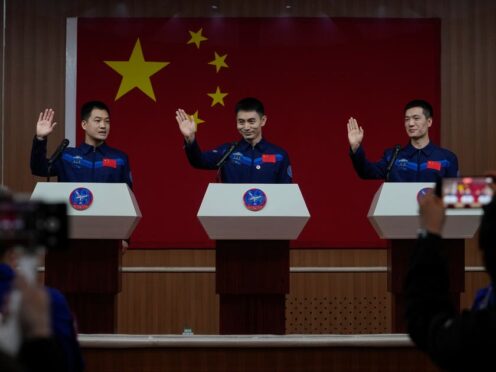
China’s space agency is making final preparations to send the Shenzhou-18 crew into low-Earth orbit as part of its ambitious space program that aims to put people on the moon by 2030.
In a press conference on Wednesday, the China Manned Space Agency (CMSA) introduced the three astronauts: Commander Ye Guangfu, 43, a veteran astronaut who was part of the Shenzhou-13 mission in 2021; and astronauts Li Cong, 34, and Li Guangsu, 36, who will go to space for the first time.
The three-member crew’s spacecraft is set for lift-off at 8.59pm local time (1.59pm BST) on Thursday from the Jiuquan Satellite Launch Centre on the edge of the Gobi Desert in the country’s north-west.
They will relieve the Shenzhou-17 team, who have manned China’s Tiangong space station since last October.

The crew will spend about six months on the space station. They will conduct scientific tests, install space debris protection equipment on the space station, carry out payload experiments, and popularize science education, among other things, according to Lin Xiqiang, deputy director of the CMSA.
Mr Lin also said China was working toward eventually offering access to its space station to foreign astronauts and space tourists.
“We will accelerate the research and promotion of the participation of foreign astronauts and space tourists in flights with China’s space station,” he said.
“We definitely expect to see astronauts of different identities on China’s space station.”
China built its own space station after being excluded from the International Space Station, largely due to the United States’ concerns over the People’s Liberation Army’s involvement in the programme.
This year, the Tiangong space station is slated for two cargo spacecraft missions and two manned spaceflight missions.

China conducted its first manned space mission in 2003, becoming the third country after the former Soviet Union and the US to put a person into space using its own resources.
The US space programme is believed to still hold a significant edge over China’s due to its spending, supply chains and capabilities.
However, China has broken out in some areas, bringing samples back from the lunar surface for the first time in decades and landing a rover on the less explored far side of the moon.
The US – the only country to have previously put astronauts on the moon – aims to put a crew back on the lunar surface by the end of 2025 as part of a renewed commitment to crewed missions, aided by private sector players such as SpaceX and Blue Origin.
Four countries, the US, Russia, China and India, have landed spacecraft on the moon.

Enjoy the convenience of having The Sunday Post delivered as a digital ePaper straight to your smartphone, tablet or computer.
Subscribe for only £5.49 a month and enjoy all the benefits of the printed paper as a digital replica.
Subscribe